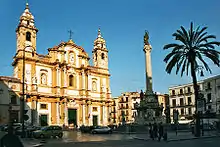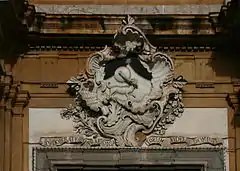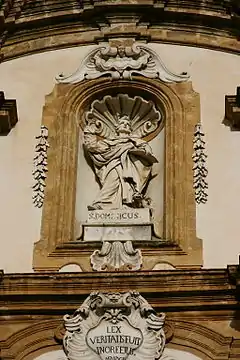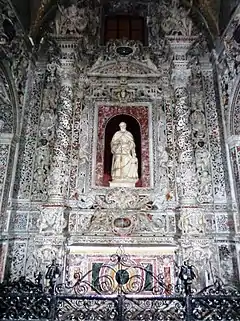San Domenico, Palermo
The Church of Saint Dominic (Italian: Chiesa di San Domenico or simply San Domenico) is a church in Palermo, Sicily, southern Italy. It is located in Piazza San Domenico, in the quarter of La Loggia, within the historic centre of the city. The church hosts the burials of many figures of Sicilian history and culture. For this reason it is known as the "Pantheon of illustrious Sicilians".
| Church of Saint Dominic | |
|---|---|
Chiesa di San Domenico (in Italian) | |
 | |
| Religion | |
| Affiliation | Roman Catholic |
| Province | Archdiocese of Palermo |
| Rite | Roman Rite |
| Location | |
| Location | Palermo, Italy |
| Geographic coordinates | 38°07′08.46″N 13°21′48.18″E |
| Architecture | |
| Style | Sicilian Baroque |
| Groundbreaking | 1640 |
| Completed | 1770 |
| Website | |
| Official site | |




History
The origin of the building dates back to the Middle Ages. A first Dominican church was built on this site between 1280 and 1285. The church was in Norman–Gothic style and it was also fitted with a convent and a cloister that represented a small and simple reproduction of the more famous Benedectine cloister of Monreale. Inside this primitive church the son of James I of Cyprus, Odo, was buried in 1420 (or 1421).
_Pieta_von_Domenico_Gagini.jpg.webp)
At the beginning of the 15th century the medieval church became too small for the needs of a growing community of believers. For this reason the friars sought the financial aid of Pope Martin V and of the wealthiest families of Palermo. The new church was built in Renaissance style. However, through the natural course of time, also this building became too small for the liturgical needs of friars and believers. Therefore, in 1630, the Dominicans of Palermo commissioned architect Andrea Cirrincione to build a new church. Ten years after, on 2 February 1640, there was the groundbreaking ceremony. The work required many decades. The Baroque façade was completed in 1726, while the left bell tower dates from 1770.[1]
During the Sicilian revolution of 1848, in this church the Sicilian Parliament was called under the leadership of Ruggero Settimo. In 1853 the church became the pantheon of illustrious Sicilians.[2]
Convent
The convent, founded in 1300, is located north of the church and can be accessed from the latter's north aisle. The cloister, founded by the Chiaramonte family, has column and arches including manufacts from the early 13th century building.
The walls have paintings portraying Dominican saints, scenes of Apocalypse, of the Last Judgement and works by Nicola Spalletta from Caccamo. The interior houses a refectory and a large library.
Burials
See also
| Wikimedia Commons has media related to San Domenico (Palermo). |
- Piazza San Domenico, Palermo
- Oratorio del Rosario di San Domenico
- Victory column: Colonna dell'Immacolata, Palermo
References
External links
- (in Italian) History of the church – Associazione Chiese Storiche